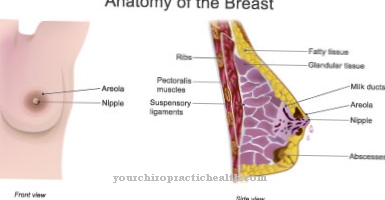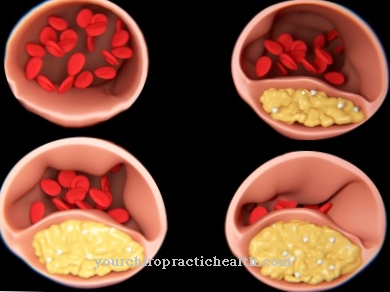Under one Baker's cyst one understands a kind of bulge that is located in the hollow of the knee and is filled with fluid. It is often the result of chronic internal diseases of the knee joint.
What is a Baker Cyst?

© joshya - stock.adobe.com
The Baker cyst owes its name to the English surgeon W. M. Baker, who first described the Baker cyst in the 19th century.
From the outside, the Baker's cyst looks like a tumor in the hollow of the knee; this must be excluded as soon as possible. The starting points of the Baker cyst are either directly on the posterior joint capsule of the knee, on the calf muscle musculus gastrocnemius or on the flexor muscle musculus semimembranosus, which runs on the back of the thigh to the knee.
However, the joint capsule is mainly the place where the cyst forms. When the cyst ruptures, the fluid leaks into the surrounding tissue and the pain in the area increases. A Baker's cyst usually occurs in middle to advanced age.
causes
So-called internal diseases of the knee joint are the cause of a Baker's cyst, in which the body produces more synovial fluid. The result is a steady increase in pressure in the joint and a bulge on the joint capsule, the Baker's cyst, can develop.
This liquid-filled capsule can be felt well in the hollow of the knee and resembles a blister on the foot when lightly pressed. But other diseases of the joint can also promote the formation of a Baker's cyst, such as chronic polyarthritis or long-standing meniscus symptoms.
You can find your medication here
➔ Medicines against edema and water retentionSymptoms, ailments & signs
Baker's cyst is first noticeable as tenderness on the back of the affected knee. The pain, which is initially still diffuse, often occurs with greater stress, such as during sports or long walks. As the cyst develops, the pain becomes more noticeable.
Soon the cyst will also be palpable during the self-examination. The surrounding tissue is also swollen and may be reddened. The cyst forms inside the knee as a result of an accumulation of knee fluid that the body cannot break down on its own. A capsule is created around the water pool. This system fills up over time and causes uncomfortable to severe pressure pain under stress.
As the disease progresses and the cyst continues to grow, the mobility of the knee becomes even more limited. Strong discomfort occurs when walking. Climbing stairs in both directions can be particularly painful. In contrast, when the musculoskeletal system is immobile, the cyst does not cause pain of its own.
The problem of Baker's cyst is often exacerbated by the patient's poor posture due to pain. Since the musculoskeletal system is often stressed mainly on one side on the unaffected side, other joints are overloaded, which can lead to further inflammation or painful tension.
Diagnosis & course
The diagnosis of Baker's cyst is based on the symptoms and a physical examination. Because even pressing in the hollow of the knee causes severe pain in the patient.
If a physical exam is insufficient to determine the Baker's cyst with certainty, an X-ray will also be taken. Because then it can be differentiated: is it really a Baker cyst or knee joint arthrosis, or even a tumor that is causing the symptoms.
An ultrasound examination can also show how big the cyst is and how far it has already spread. If the cyst is tubular, or is already cracked or bleeding, the diagnosis can be complicated. Often the symptoms can improve on their own in the further course. A Baker cyst can disappear spontaneously, but it can also reappear when exposed to stress.
Complications
If the Baker's cyst has established itself in the knee joint, measures must be taken immediately, as the condition can acutely worsen. The increased production and accumulation of synovial fluid in the knee joint capsule can cause permanent damage. A number of complications follow, which cause the patient uncomfortable pain.
The cyst does not only occur in older people, athletes and workers who are exposed to high knee strain also belong to the risk group. At times, bacteria, rheumatoid diseases, an accident or a knee operation can trigger a change in the viscous synovia. As soon as blood is mixed in with the fluid, the cartilage can be aggressively damaged.
Immobilizing the leg in combination with anti-inflammatory drugs or cortisone helps avoid complications. If the cyst cannot regress using conservative methods, surgery is the best way to get rid of this problem in the long term. If the swelling is ignored, the Baker's cyst will keep forming again.
If synovial fluid increasingly accumulates, the surrounding healthy tissue is compressed. Numbness and paralysis appear and extend to the foot. The pain intensifies, the cyst bursts and its fluid spreads into the lower leg muscles. Symptoms of a lower leg thrombosis occur.
When should you go to the doctor?
A Baker cyst does not require immediate medical attention. However, if severe symptoms develop, a visit to a doctor is recommended. If the cyst presses on the nerve tract, for example, this can cause unpleasant sensory disturbances.
Severe knee pain, abnormal sensations in the lower legs and feet, and persistent ankle pain can also occur. If one of these symptoms persists longer than usual, a doctor must clarify the disease and, if necessary, initiate treatment immediately.
In general, as soon as a Baker cyst significantly reduces the quality of life, it should be treated medically. An emergency doctor should be called if the cyst slips or bursts - for example, as a result of a rupture or inflammation of the surrounding tissue. If left untreated, fluid can build up and the lower leg can be lost as a result.
For this reason, first aid measures must sometimes also be used. Until the ambulance arrives, the affected person should keep their legs up and carefully bandage the Baker's cyst. Even the suspicion that a cyst could open should lead to a doctor.
Doctors & therapists in your area
Treatment & Therapy
Baker's cyst can be treated both conservatively and surgically. The aim of both methods is to completely eliminate the swelling that has occurred in the hollow of the knee and the pain associated with it. With a Baker's cyst in childhood, conservative therapy is usually sufficient to achieve complete freedom from symptoms.
If there is no improvement, surgical therapy is useful, but also if the cause is, for example, meniscus damage and these symptoms are also to be alleviated. This also prevents the formation of a new Baker cyst. In conservative therapy, the main focus is on treatment with drugs that have anti-inflammatory effects.
Cortisone is also used, even if its use is controversial (due to side effects). Here, a cortisone preparation is injected into the knee joint so that the inflammation is stopped locally. If the cyst has not regressed after half a year, the Baker cyst is usually surgically removed. Care must be taken to ensure that the stem that connects the joint and the cyst is tied.
Outlook & forecast
The prognosis of a Baker cyst is very favorable. The cyst can usually be completely removed by a doctor in a few simple steps. The wound care should be sterile so that no sequelae develop. The patient can be discharged from the treatment within a short period of time without any symptoms.
Depending on the location and size of the cyst, surgery may be necessary in some cases. This is a routine process that also takes comparatively little time. The patient is discharged home from the treatment on the same day after the procedure. The patient should give himself a few days of rest until he is also symptom-free.
The wound is very rarely contaminated. This leads to a delay in the healing process. If no further medical treatment is sought, germs or pathogens can enter the organism and trigger further diseases.
In severe cases, the patient is threatened with blood poisoning, which can be fatal. The position of the Baker's cyst may have restricted the movement of the knee. In order not to endanger the healing process, the patient should not overexert himself and keep the knee sufficiently still. The mobility of the knee begins immediately during recovery and is then available as usual.
You can find your medication here
➔ Medicines against edema and water retentionprevention
Only certain causes of Baker's cyst can be prevented. For example, if you already have meniscus symptoms, you can avoid stressful sports or not perform certain movements, as is the case with tennis or football. You should then do sports that are easy on the knee, such as cycling or swimming. If you like jogging in the fresh air, you can try walking as an alternative. Those who work in the office should change their sitting positions frequently so that the knee joint is not always in the same position.
You can do that yourself
Swelling in the hollow of the knee should be observed. The cause may be damage to the knee joint to be treated. For mild or moderate pain, over-the-counter pain relievers such as ibuprofen or diclofenac help. Basically, the knee should be kept still. In addition, a cooling pad can be placed in the hollow of the knee.
In addition to pain relievers, selenium can be taken in capsule form. This micronutrient reduces inflammation in the body. The homeopathic remedy arnica also has an anti-inflammatory effect. This can be taken for acute treatment or after an operation.
If there is no improvement within a day, the family doctor, an orthopedic surgeon or surgeon should be consulted. If the cyst regresses but returns regularly, those affected should take care to protect their knees. Sports that put stress on the joints such as tennis or soccer should be replaced by swimming, gymnastics or cycling.
Through targeted exercises - which can also be taught in physiotherapy (rehabilitation sport) - muscles are built up that protect the knee joint and strengthen the musculoskeletal system. In addition, gentle movement promotes the formation of synovial fluid. This reduces the risk of inflammation in the knee joint.
People who are overweight should try to reduce their weight in order to reduce the strain on the knees. If everyday life is predominantly a sitting position, it is advisable to change your working position frequently. The acquisition of a standing desk could help.



.jpg)









.jpg)

.jpg)
.jpg)











.jpg)